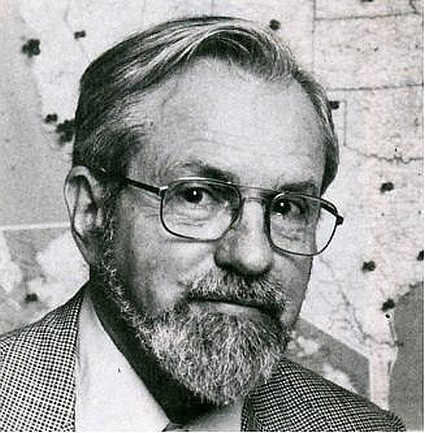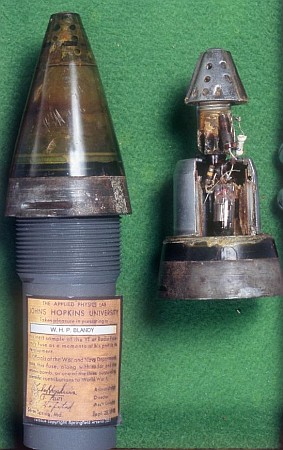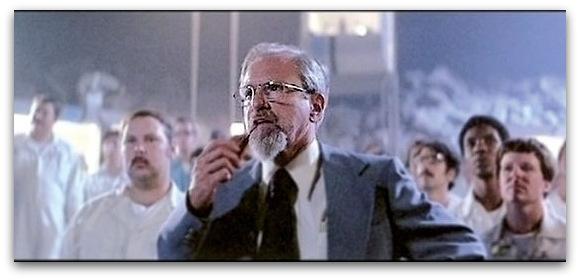
With the new book, The Close Encounters Man: How One Man Made the World Believe by Mark O'Connell, one of Ufology's most iconic and conspicuous members returns to the public eye.
As O'Connell's book points out, Hynek, a competent scientist with significant mainstream achievements, continues to be best known for his advocacy that UFOs should be investigated as a scientific pursuit.
The following excerpt taken from Hynek's FBI file demonstrates one example of the importance of his scientific work while at the Applied Physics Laboratory at Silver Spring, Maryland, during World War II.
News clipping from the Washington Post, page 1 - (copy too poor to reproduce)
In a building of mystery at 8621 Georgia Ave., Silver Spring, was developed the radio proximity fuse rated with radar and the atomic bomb as one of the three great scientific developments of the war.
Shared with the British and French armed forces, but denied to the Russians, it made possible the following successes in recent combat:
1. It had a large part in defeating the kamikaze - or suicide Jap bombers at Okinawa.
2. It was the answer to the German V-1 buzz bomb, which it virtually rendered impotent.
3. It provided American artillery in the Battle of the Bulge last December with the most potent antipersonnel weapon ever developed and practically stopped German ground troops in their tracks.
4. It was the most deadly answer to air attack when used by anti-air artillery ever developed.
Yesterday afternoon in the conference room of the building a group of scientists, headed by Dr. Allen Hynek, astronomer loaned by Ohio State University, told the four-year old secret. It was in this room that all the top secret plans were made.
With Dr. Hynek were Robert C. Herman, physicist, of City College of New York; Dr. Edward D. McAllister, physicist of the Smithsonian Institution; Dr. Lawrence Hafstead of the Carnegie Institution of Washington; Capt. Paul Teas, Ordinance Department, U.S. Army, a former chemical engineer of Cleveland, Ohio, and David Luke Hopkins, trustee of Johns Hopkins University of Baltimore, business director of the project.
Among the statistics on the venture, known as Navy Project A, as related by its sponsors, are:
1. Total amount spent $800,000.
2. Fuses built, 20,000,000. At the end of the war production had reached a peak of 500,000 a day. Cost per fuse $18.
3. Eighty thousand persons employed throughout ?? its development and ? of which 80 percent were women.
4. Three per cent [??]
Originally a project sponsored by the Navy Department and designed primarily as a defense for war ships against air attack, it developed into such a potent ground weapon that 80 per cent of the fuses went to the Army in the closing months of combat.

The device is a radio-operated fuse designed to screw into the nose of a shell and timed to explode at any desired distance from target. It contains a wet-tube battery inclosed in glass. The concussion of the shell charge breaks the glass container, the acid spilling into a series of radiator cells that form the cells of a battery furnishing energy to five tiny radio tubes, slightly more than an inch in length. These radio tubes operate a midget radio transmission, that sends out radio beams. When nearing its target the beams bounce back, setting off the fuse and exploding the shell charge.
During the Battle of the Bulge the Germans came into possession of a number of the fuses from dud shells. However, in the confusion they apparently were unable to do any research into them, and the dump in which they were stored was captured before the entry into Berlin.
“We are convinced from a record kept of the shell fired that failed to explode, that we have recovered all samples of the shell that fell into the hands of the enemy,” Dr. Hynek asserted.
Without the proximity fuse Dr. Hynek said, the war probably would still be on.
The work of the group of scientists engaged in the proximity fuse project and in the atom bomb development was merged at the bombing of Hiroshima and Nagasaki. The atom bombs were equipped with proximity fuses that made possible their explosion at sufficient altitude to do terrific personnel and material damage without impregnating the area with deadly atomic rays. In fact, a representative from the proximity fuse project accompanied the Army pilots on the atomic bomb raids.
The wind-driven generator for use on bombs and jet-propelled or rocket missiles was developed at the U.S. Bureau of Standards
Project 1947 is primarily concerned with Hynek's UFO-related work. Some of his activities are not well known or are lost to researchers as Hynek's contracts with the U.S. Air Force were handled through intermediaries.
One such project, Project Henry, was funded by the Air Force through the Battelle Memorial Institute. What we think was one of his last contracts on UFOs was administered through McGraw-Hill.
Hynek's submissions through McGraw-Hill contain some interesting insights into his investigations. Some of his submissions, for example, did not reach Project Blue Book. Both the Captain Frost 1945 sighting and the Slidell Louisiana, December 8, 1957 “car buzzing incident”, do not appear in the Project Blue Book files.
After the Condon Report was made public, Hynek submitted a UFO research proposal to the Air Force. How it was received is currently unknown, but Hynek did have a contract with the Air Force from 1970-1974. The nature of his work under this commitment is unknown. It could have been some scientific investigations or advice having nothing to do with UFOs, but during the period of this contract his first UFO book, The UFO Experience: A Scientific Enquiry was published.
Another telling submission made under Hynek's contract was to inform the Air Force that as Donald Keyhoe had pointed out in his 1966 TRUE magazine article, Keyhoe – or more accurately the National Investigations Committee on Aerial Phenomena (NICAP) – had details of many UFO cases which had never come to the attention of the Air Force. An interesting observation in light of what would happen once Hynek founded the Center for UFO Studies (CUFOS).
The Center's files contained much of the material which Hynek had accumulated during his tenure as Air Force advisor. He received submissions of UFO information from various sources outside the Air Force, while many Air Force cases were also submitted to him. In some cases, he (and now CUFOS) had Air Force UFO reports which are no longer found in the Project Blue Book files. When the Project Blue Book files were archived to microfilm, Hynek received a copy which added to his collection of two of the Project Sign microfilms already in his possession.
Reports came to the Center from the CUFOS investigation network from many sources. Police often reported UFO-related incidents directly through a “hot line.” Dr Hynek made a cameo appearance in the movie Close Encounters of the Third Kind, and when the film was released there were CUFOS UFO questionnaires available in the theater lobbies creating further opportunities for sighting reports to be obtained.

With the decline of NICAP, CUFOS was able to obtain most of the NICAP's files. The NICAP holdings included UFO reports obtained through its own investigative network, and the files of predecessor organizations such as Civilian Saucer Investigations of Los Angeles and Civilian Saucer Intelligence of New York, Lee Munsick's files and the files of other organizations and individuals.
Loren Gross commented on his sources for the UFO History Series:
“I checked every frame of the USAF Project Blue Book microfilms for the years 1947-1963. There are many Information Only cases in the records, but also, I might add, there are news clippings, magazine articles, and items from civilian UFO publications. Over the years I was able to compare the PBB records with many other sources including, APRO, CUFOS, NICAP, Dr. James McDonald's papers, Ruppelt, various newspaper clipping collections such as Gribble's, and every UFO book available, etc. Remarkably, there is very little overlap aside from well-known incidents….”
CUFOS, as the repository of this vast amount of material, probably has the largest amount of UFO information in North America, several times bigger than the Project Blue Book files. However, Hynek's comments about cases which were never officially submitted or acknowledged by government agencies still applies today; even the CUFOS holdings represent only a fraction of what exists.
— Jan L. Aldrich
Dr Hynek's Critique of Donald E. Keyhoe's Jan, 1966 TRUE Magazine article in which he outlines how Keyhoe via NICAP had access to many UFO incidents unknown to the USAF: [Read the original TRUE Magazine article here.]
Details and Memoranda of Dr J. A. Hynek's 1967 USAF-sponsored UFO investigation contract. Includes details of several “Orphan” UFO cases which never appeared in Project Blue Book.
Dr Hynek's Preliminary Proposal for Subject Investigation, outlining a “pilot line study of a certain subset of UFO reports”. Includes a number of EM effect cases. - Transcribed by Andrea Nick.